-
History & Society
- Education in Pre-war Hong Kong
- History of Taikoo Sugar Refinery
- Hong Kong Products Exhibition
- Local Festivals Around the Year
- Post-war Industries
- Pre-war Industry
- The Hong Kong Jockey Club Archives
- Tin Hau Festival
- Memories We Share: Hong Kong in the 1960s and 1970s
- History in Miniature: The 150th Anniversary of Stamp Issuance in Hong Kong
- A Partnership with the People: KAAA and Post-war Agricultural Hong Kong
- The Oral Legacies (I) - Intangible Cultural Heritage of Hong Kong
- Hong Kong Currency
- Hong Kong, Benevolent City: Tung Wah and the Growth of Chinese Communities
- The Oral Legacies Series II: the Representative List of the Intangible Cultural Heritage of Hong Kong
- Braving the Storm: Hong Kong under Japanese Occupation
- A Century of Fashion: Hong Kong Cheongsam Story
Geography & EnvironmentArt & Culture- Calendar Posters of Kwan Wai-nung
- Festival of Hong Kong
- Ho Sau: Poetic Photography of Daily Life
- Hong Kong Cemetery
- Sketches by Kong Kai-ming
- The Culture of Bamboo Scaffolding
- The Legend of Silk and Wood: A Hong Kong Qin Story
- Journeys of Leung Ping Kwan
- From Soya Bean Milk To Pu'er Tea
- Applauding Hong Kong Pop Legend: Roman Tam
- 他 FASHION 傳奇 EDDIE LAU 她 IMAGE 百變 劉培基
- A Eulogy of Hong Kong Landscape in Painting: The Art of Huang Bore
- Imprint of the Heart: Artistic Journey of Huang Xinbo
- Porcelain and Painting
- A Voice for the Ages, a Master of his Art – A Tribute to Lam Kar Sing
- Memories of Renowned Lyricist: Richard Lam Chun Keung's Manuscripts
- Seal Carving in Lingnan
- Literary Giant - Jin Yong and Louis Cha
Communication & Media- Hong Kong Historical Postcards
- Shaw Brothers’ Movies
- Transcending Space and Time – Early Cinematic Experience of Hong Kong
- Remembrance of the Avant-Garde: Archival Camera Collection
- Down Memory Lane: Movie Theatres of the Olden Days
- 90 Years of Public Service Broadcasting in Hong Kong
- Multifarious Arrays of Weaponry in Hong Kong Cinema
-
History & SocietyGeography & EnvironmentArt & Culture
-
View Oral History RecordsFeatured StoriesAbout Hong Kong Voices
-
Hong Kong MemorySketches by Kong Kai-mingRecently Visited
All Items
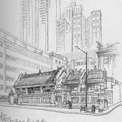
-
Man Mo Temple at Hollywood Road
The Man Mo Temple in Hollywood Road is the best-known of all the temples in Hong Kong. It was dedicated to the Literary God and the Martial God. It was built during the years 1842-1847 and extended in 1850. In 1960s, an outer wall was erected. The Chinese community settled early in the neighbourhood of Hollywood Road.-

- 1977
-
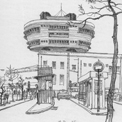
-
Victoria Peak
In almost every country, telescopes are provided at high view points in scenic spots. Victoria Peak in Hong kong is no exception. In 1955, a viewing pavilion was built on the cliff north of the Peak Tram terminal. It was called "Bao Ning Sightseeing Pavilion", nicknamed "The Fool's Pavilion". It was in use for fifteen years.-

- 1979
-
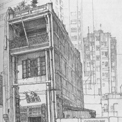
-
Bak Cheung Tong at Bonham Street West
Rise and Fall of the Nam Pak Hong. The term Nam Pak Hong referred to the entrepot trading firms in Bonham Strand West, Bonham Strand and Wing Lok Street in Sheung Wan. They were mainly engaged in exporting non-staple foodstuffs from places north and south of the Yangtze River. Their business later expanded to Southeast Asia, Japan, Europe, the United States and Africa. The one with the longest history was Yuen Fat Hong, followed by Kin Tai Long Hong, which opened in 1851. The North and South Hongs were basically organised along the lines of the "Thirteen Hongs" in Guangzhou. It first acted as a middleman and charged a commission equal to two percent of the goods' value. The Nam Pak Hong Association was formed in 1868 to unify those in the same business in their fight for benefits. The existing building in Bonham Strand was built in 1954. As members charged a commission of two percent, the association was also known as the "Ninety-Eight Percent Hong." The Nam Pak Hong was most prosperous by the turn of the 20th century. In 1922 and 1925, Hong Kong's economy suffered as a result of two major strikes by seamen, with firms closing down one after another. After 1949, China began nationalising the export business, and also in recent years, it has opened its doors again. Competition in the market became keen, and the new generation has its own way of doing business. Today, the Nam Pak Hong is no longer what they used to be in the past. The early Nam Pak Hong celebrated Lunar New Year by organising parties and setting off firecrackers. Companies were decorated with lanterns as a sign that they were not in debt. On the days of spring and autumn worshipping ceremonies, operas were arranged to entertain the neighbourhood. In the early years, Hong Kong was not very peaceful. Even the police could not offer much help. The Nam Pak Hong therefore organised their own patrol bureau. Guards armed with guns patrolled the area night and day. The three most important Chinese guilds, the Nam Pak Hong, the Silk Hong and the Mortgage Hong, jointly owned Hong Kong's only three fire engines, but their operation was under the command of the government's Fire Services Department. The government's fire-fighting squads were formed in 1868 as part of the police force. The insignia of the Nam Pak Hongs was not fixed until 1951. It features a map including Asia, Europe, Africa and Australia, together with planes, ocean liners and trains. Japan and the Philippines however were omitted from the map. Even members of the Hong were baffled by this omission.-

- 1987
-
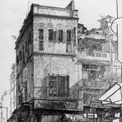
-
The Old Pawnshop at Hollywood Road
Pawnbroking existed in Hong Kong long before it became a colony. It came into existence in the Tang Dynasty (618-907) and was very popular in the Sung Dynasty (906-1279). In the past, pawnbrokers were only found in market towns, mostly in Yuen Long. Pu Yuan Pawnshop in Yuen Long Old Market has had a history of 200 years. In the early days, the people of Hong Kong were mostly labourers. They spent their leisure time gambling and often had to pawn valuables to get cash. The trade flourished and many pawnbrokers moved in. A pawnbroker was popularly known as "second great uncle". Pawnbrokers at that time had to pay a license fee and ordinary taxes like other traders. But they found it difficult to avoid taking in stolen goods. In 1858, the owner of the Fu Hui Pawnshop was sentenced to fourteen years' banishment (banishment was abolished in 1911) for handling a stolen pocket watch. The Chinese saw this as racial prejudice and organized a signature campaign. Under this pressure, the governor at that time, Sir John Bowring, changed the sentence to two years' imprisonment. In 1853, pawnbrokers went on strike for the first time in protest against harassment by the police. In 1858, they went on strike again when they thought the license fee was too high. The "King of Pawnbroking", Li Yau Chuen , was honoured in 1929 for his contribution to the trade. In that year, he had an 80% share of all pawnshops in Hong Kong. The trade thrived during the Japanese occupation when it was the only trade with good business. In the 1970s, credit companies emerged and banks were set up one after another. Land prices and rent were also high. Pawnbroking gradually declined even though pawnbrokers changed their manner of operation.-

- 1981
-
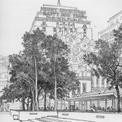
-
Headquarters of Hongkong and Shanghai Banking Corporation (1979)
The Fate of the Invaluable "Imported Building". The construction cost of the old Hong Kong and Shanghai Banking Corporation headquarters was no less tremendous than that of the new one. The old headquarters was built in 1934 and demolished at the age of 47 in 1981. The construction materials of this bank which was supposed to be the most advanced, between Cairo and San Francisco, apart from a small quantity of granite rocks and tiles, were mainly imported, including the pair of bronze lions at the main entrance which were from Shanghai. Designed by an English architect, the old headquarters was the first building in Hong Kong which employed British stainless steel scaffolding rather than the traditional Chinese bamboo type. The imported construction materials included marble from Italy, hollow bricks for the lobby floor produced by a British machine, and the reinforcing bars which were of high-quality chromadon steel from Canada. The window frames were made of stainless steel or bronze and the window panes were 1/4 inch thick, while the door of the high-security vault weighed 26 tons. The walls of the lobby were of Botticine marble, the columns were of green marble from Sweden, and all the stair handrails, and lighting lamps were of bronze. The ceiling mural in the lobby, was an Italian glass mosaic, was designed by a well-known Italian designer. The mural depicted generally the developments of transportation, industry and commerce in East and West . In the central upper part of the mosaic there was a carriage crossing the sky, carrying Apollo and the God of Fortune, whereas the two ends showed banking developments in East and West. The mural was a magnificent work of art with dazzling colours. But, however beautiful, it was divided up into pieces as souvenirs for the people connected with the bank when the building was demolished.-

- 1979
-
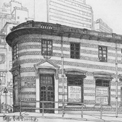
-
The Fringe Club
The Fringe Club is devoted to promoting all types of 'fringe arts' that are not wholly recognized by the arts establishment or the general public. It is an open stage and creative workshop for various unknown arts and crafts. Established in 1982, the Fringe Club is a non-profit making voluntary organization. It shares its premises with the Foreign Correspondents Club in an old red-brick building, originally built by Dairy Farm in 1913, at the junction of Wyndham Street and Ice House Street. Nearby is a road of lane called Lan Kwai Fong where Fringe artists (especially Westerners) sometimes give free performances to entertain passers-by. In fact, there were already quite a lot of street performers in the early days of Hong Kong. Lan Kwai Fang was originally something like a village, with a memorial archway at the entrance and exit, forming an L-shape. Inside it, there were clan halls and temples which have been replaced by restaurants, lounges and bars nowadays.-

- 1987
-
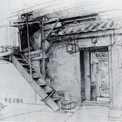
-
Law Uk, Chai Wan
The "Law UK" is a one of houses in a Hakka walled village in Chaiwan with an area of more than 1,000 square feet. It is more than 200 years old. The owner's family name was Law. The land deed of the house was issued in 1768 (the 32nd year of the reign of Chien Lung). During the 18th century the Chinese government issued a public decree to encourage Hakkas to migrate south and probably the Laws were among the immigrants.-

- 1986
-
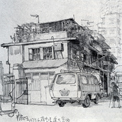
-
Flea Market on Hollywood Road
Lin Tse-hsu and Teng Ting-chen failed to suppress the opium trade and were fired by the Qing government. Manchu official Qi Shan succeeded and he secretly signed the Convention of Cheunpi with the British Government on January 21, 1841, in which Hong Kong was ceded to the British Government. On January 26, Commodore Bremer, leader of the Naval Forces, commanded the first landing at Shui Hang Hau, Sheung Wan. The British flag was hoisted on a hill as part of a ceremony to proclaim the "takeover" of Hong Kong. The place of landing has since been named Possession Point. This hillside later became Hollywood Road's Flea Market. In the old days, barber shops, palmists and eateries were found in the Market. The barber shops did not charge fees at that time as they were training-grounds for apprentices.-

- 1977.6
-
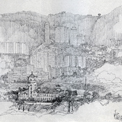
-
Government House
Government House on Upper Albert Road in Central was built in 1855. A side wing was added in 1890-1891. During the Japanese occupation, the building was renovated and has remain unchanged until today. Hong Kong's political system was patterned after the basic colonial model for British overseas territories. The governor was appointed by the Crown to be Britain's representative in Hong Kong. He beared the title of Commander-in-Chief. As head of government, the governor presided over the Executive and Legislative Council meetings and appointed Council members. Council members had to take an oath of allegiance to the Queen but now they can take an oath of allegiance to Hong Kong. In the past, residents of Hong Kong had no right to question political issues - but nowadays, during the transitional stage to Chinese sovereignty and amidst the "representative government" movement, some councillors are elected. The government's responsibilities were: (1) to guard against external enemies, (2) to maintain law and order, (3) to conduct court hearings and (4) to develop infrastructure. The constitution includes:(1) the political system, (2) government structure, and (3) detailed ordinances (written and unwritten laws).-

- 1980
-
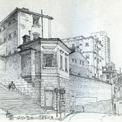
-
Victoria Prison
Two solidly built prisons were erected by the British Government: Victoria Prison and Lai Chi Kok Prison for Women(built in 1932).In 1862 there was not enough room at Victoria Prison. A deserted ship was converted into a floating prison near Stonecutter's island. The first open prison was set up in Chi Ma Wan on Tai Yue Shan (Lantau Island) in 1956. Shek Pik prison, the most modern prison, has maximum security facilities and was completed in 1984. It can accommodate about 200 prisoners serving long sentences. There are altogether around 10,000 prisoners in Hong Kong. In 1982, the Prison Department became the Correctional Services Department. The Central Police Station on Hollywood Road (commonly known us 'Tai Koon' or No. 1 Police Station) was built in 1857. To facilitate easy escort of prisoners, Victoria Prison and Magistracy were built next to it. On July 3, 1845, a Chinese called Chan Ah Foon and a British navy officer were convicted of man slaughter and were put to death, the first execution in Hong Kong. Convicted criminals could be caned (by cane or rattan). Around 1860, Chinese convicts were tattooed (with a small arrow) on the left ear-lobe. This measure prevented deported convicts from sneaking back.In 1966 capital punishment was abolished and replaced by life imprisonment. Prisoners were allowed to work and were given a chance for further education. In 1988, Mr. Chan became the first prisoner to receive a bachelor's degree while in prison.-

- 1987
-
Copyright © 2012 Hong Kong Memory. All rights reserved.
| Set Name |





